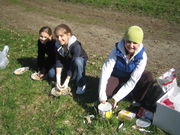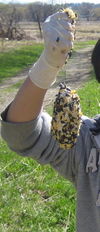Bird is the word
Biology in Middle Schools home | |Elementary School sister project
Biology In Middle Schools is a Saint Michael's College student project. Link under 'toolbox' for a printer-friendly version. Click on handouts to print full resolution versions. Please see Wikieducator's disclaimer, our safety statement, and the Creative Commons licensing in English and in legalese.
Primary biological content area covered
Students will create their own bird feeders and learn about several local bird species in the process.
Materials
- Pinecones
- Crisco
- Raisins
- Yarn or wire
- Birdseed
- Aluminum trays
- Plastic knives
- Scissors
- Plastic bags
Handouts
Step 1: Assemble materials- Crisco mixture in a bowl & birdseed spread across a tray
Step 2: Tie yarn or wire onto top of pinecones
Step 3: Mix and spread Crisco over pinecone
Step 4: Roll pinecone in birdseed and raisins
Step 5: Suspend bird feeder from a branch with its string
Description of activity
Students will build pinecone bird feeders consisting of Crisco, birdseed, and raisins. In addition to the bird feeders, we will be educating the students on bird identification with the help of The Bird Feeder Book-An Easy Guide to Attracting, Identifying, and Understanding Your Feeder Birds by Donald and Lillian Stokes. At the conclusion of our lesson, the students will be able to bring their bird feeders home to suspend in any area where birds are likely to visit.- Each student will receive their own pinecone
- Tie yarn or wire to the top of each pinecone
- Spread the fat source over each pinecone, either by rolling in a tray or by spreading with a plastic knife
- Roll each pinecone in tray filled with a mixture of bird feed and raisins
- Pinecones are set aside to dry on wax paper during bird identification discussion
- Discuss physical characteristics and diets of several local bird species we are likely to see. Bird species will include: Northern cardinals, black-capped chickadees, American goldfinches, red-winged blackbirds, and song sparrows.
- Pick up pinecones and place in individual plastic bags with their names on them
Potential pitfalls
The possibility of birds not visiting the pine cone feeders is likely due to the time of the season or not enough time for the birds to recognize the feeders as a food source.
Math connections
N/A
Connections to educational standards
Our lesson allows the students to observe local birds in their natural habitat. These educational standards are set by Vermont's Department of Education as part of the Life Science Section for 5th and 6th graders. Students should be able to intuit as to why fat would be a valuable resource for nonmigratory bird species during winter and be able to tie this into energy flow within an ecosystem. Link: http://education.vermont.gov/new/html/pgm_curriculum/science/gle.html
Next steps
If the students want to test out their bird feeders during the winter time, they could try an informal experiment to see if the birds have food preferences during winter. One would assume that, during the winter, birds would want food with the greatest caloric density, since food during the winter time is so scarce. If this assumption were true, the birds would presumably gravitate towards sources of fat. The informal experiment could consist of placing two sets of pinecones, each adorned with different food sources (i.e., sugars vs. fats), to see if one type of food more readily attracts birds during the winter time.
Fat sources to try: peanut butter or Crisco covered with shelled sunflower seeds
Sugar sources to try: honey covered with raisins or other dried fruits
Reflections
Overall, the kids seemed to really enjoy this activity. Education about the fat source was popular and the kids seemed to like getting their hands dirty while applying the fat to their pinecones. For the future, it would be nice to have more time for the kids to get settled and to be able to educate them on the local birds. It was hard to focus their attention given the short amount of time we received to do the activity and incorporate an educational component as well. Next time, we might try to do the educational portion first and end with making the birdfeeders. Once the kids were involved in the activity, it was hard to refocus their attention. It was unexpected that most of the kids were not interested in taking their pinecones home but rather wanted to hang them on site, which worked out in the end as we had no means of transporting their pinecones home with them. If kids desired to take their feeders home it would be beneficial to have plastic baggies or plastic wrap around to transport the pinecones.
Citations and links
Stokes, Donald W., and Lillian Q. Stokes. The Bird Feeder Book: an Easy Guide to Attracting, Identifying, and Understanding Your Feeder Birds. Boston: Little, Brown, 1987. Print.


